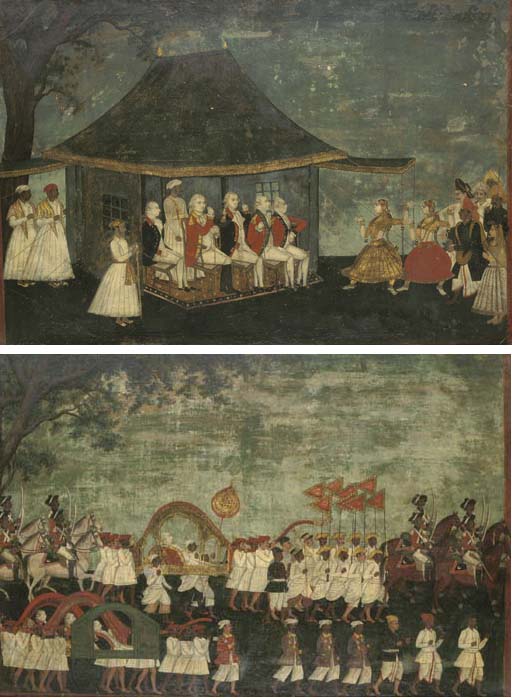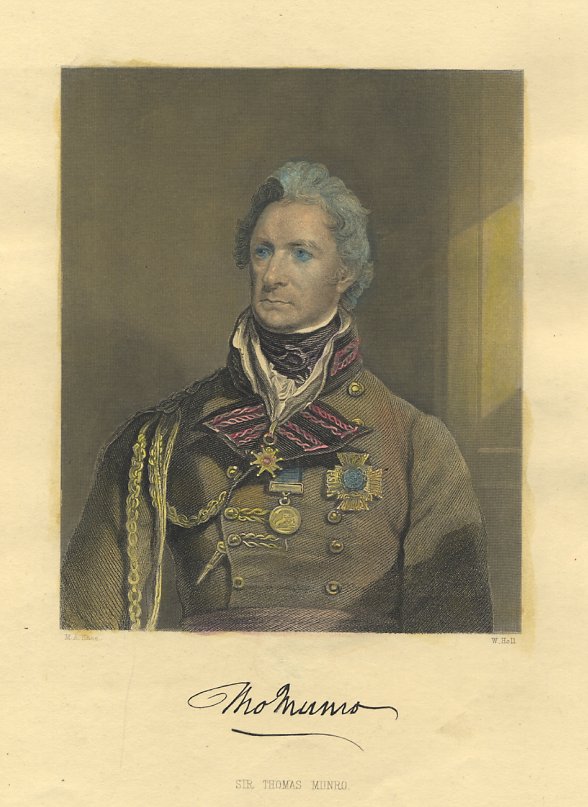

Sir John Dalling, Governor of Madras, in two Tanjore School paintings, c.1875-86
Source:
http://www.christies.com/LotFinder/search/LOTDETAIL.ASP?sid=&intObjectID=4572605&SE=CMWCAT04+106347+%2D1655137794+&QR=M+1+0+Aqc0000900+93051++Aqc0000900+&entry=india&SU=1&SN=7074&RQ=True&AN=1
(downloaded Sept. 2005)
"Tanjore School, circa 1785-6. Sir John Dalling and fellow officers in procession; and Sir John Dalling and fellow officers watching a nautch; one with inscription 'General Sir John Dalling. Bart/Governor of Madras.' (on the stretcher); pen and black ink and bodycolour, heightened with gold, varnished, on paper laid down on canvas; 24¼ x 35¾ in. (61.5 x 90.8 cm.).
Lot Notes: Sir John Dalling (c.1731-1798) joined the army as an Ensign probably through the influence of family connections with the Duke of Cumberland. He was involved as a junior officer in French wars in North America 1757-60, and from 1761-81 was stationed in the West Indies, principally in Jamaica, of which he served as Governor 1777-81. His period of office was controversial involving risky adventures on the mainland of Central America leaving the islands open to French raids during the American War of Independence, while he also managed to upset the judiciary in Jamaica before being recalled in 1781. By the iron laws of seniority he was promoted to Lieutenant General in 1782 and to a baronetcy in 1783 and finally served as Commander-in-Chief Madras 1784-86, at the end of his military career, arriving in Madras in 1785. After retirement, he was awarded an annuity of £1000 per annum. He was made a full General in 1796.
While in southern India 1785-86 he clearly commissioned these two pictures. One shows Dalling being carried in an ornate palanquin in a procession attended by three senior officers and numerous household attendants, as well as by a squadron of the Madras Native Cavalry, of great interest for their uniforms at this early date. The painting links closely stylistically with a slightly earlier processional scene now in the V & A Museum (fig.1) showing Raja Tulsaji Tanjore (reg. 1765-86) riding on horseback accompanied by numerous attendants. Later processional scenes from this school are more elaborate and crowded affairs such as Raja Serfoji in procession now in the British Library (fig. 2) of about 1820. Sir John also commissioned a charming scene of himself and fellow officers enjoying an uninhibited nautch-- two of them use an eyeglass to observe the action better. The two girls, their hands eloquently poised in classic mudras (hand gestures), are stamping rhythmically to the beat of their accompanying musicians' drums and cymbals.
Tanjore was the seat of Hindu Rajas descended from Maratha conquerors from the northern Deccan of a century earlier. Nominally subject to the Nawab of the Carnatic, in fact they were controlled by the British in Madras, who since the final extinction of French ambitions in southern India had used the fort at Tanjore as a military base. The court style of Tanjore was in transition at this period. While the long-gowned officials in the dance scene descend from the late Mughal style of the northern Deccan, the perspectival tent, the overlapping palanquins and the trees are indicative of the European influence which had infiltrated into the style since Raja Tulsaji had patronised the Scottish artist George Willison, in India 1774-80 (see Mildred Archer, India and British Portraiture, London, 1979, pp. 99-107). These two paintings are of the greatest interest notably for being amongst some of the earliest examples of Company School painting and for their sprightly depictions of contemporary life and costume in this period.
The Dalling Cabinets, which were also almost certainly acquired by Sir John Dalling whilst Commander-in-Chief in Madras, are also included in this sale."

The "Dalling cabinets," c.1786
Source:
http://www.christies.com/LotFinder/search/LOTDETAIL.ASP?sid=&intObjectID=4572683&SE=CMWCAT04+106302+%2D1655444013+&QR=M+1+0+Aqc0000900+93010++Aqc0000900+&entry=india&SU=1&SN=7074&RQ=True&AN=1
(downloaded Sept. 2005)
"A NEAR PAIR OF ANGLO-INDIAN ENGRAVED IVORY BUREAU-CABINETS-ON-EBONISED AND PARCEL-GILT STANDS. The bureau-cabinets Vizagapatam, circa 1786, the stands English, early 19th century. Each inlaid overall with panels depicting buildings, trees and flowers, surrounded by borders of scrolling foliage, with triangular open pediment above a frieze drawer and three pigeon-holes and three drawers flanked by doors enclosing two pigeon-holes and three drawers, above a hinged flap enclosing a fitted interior of pigeon-holes and drawers divided by column-drawers, above a long drawer fitted with divisions, on bracket feet, the interior and carcase in satinwood, on a rounded rectangular stand with solid three-quarter gallery above a reeded frieze, on spirally-fluted tapering legs and ring-turned tapering feet, minor variations in size and decoration, the pediment now positioned at the rear edge. The cabinets: 36¾ in. (93.5 cm.) high; 25 in. (63.5 cm.) wide; 11¾ in. (30 cm.) deep. Almost certainly acquired by General Sir John Dalling, 1st Bt. (c. 1731-1798), whilst Commander-in-Chief in Madras, circa 1786 and by descent.
Lot Notes: The beautifully engraved bureau-cabinets, serving as portable desk jewel-case and dressing-box, are designed as a miniature 'desk and bookcase' with Roman-temple pediment in the George II 'Modern' fashion popularised by Thomas Chippendale's, Gentleman and Cabinet-Maker's Director, 1754. Engraved tablets, wreathed by floral 'chintz' fashioned borders, portray magnificent villa landscapes that would harmonise with the Georgian reception dressing apartments that were hung with landscape prints. English Roman-style architecture from Colen Campbell's much reprinted Vitruvius Britannicus (published in several volumes from 1715) featured alongside views from the Haarlem publication, Her Zegepralent Kennemerlant, 1729, on a cabinet from the collection of a Governor of the Dutch Cape Colony; while scenes from R. and J. Dodsley's, London and Its Environs Described, 1761, appear on another related cabinet at Arundel Castle, Sussex. A cabinet on loan to the Victoria & Albert Museum features feet engraved with similar fantastical lions (A. Jaffer, Luxury Goods from India, London, 2002, pp. 80-81, no. 33). A related bureau-cabinet with tiger-decorated feet was sold by Robert H. Metzger, Sotheby's, New York, 27 October 1995, lot 184.
This artistic India-flowered furniture, crafted in exotic ivory
veneer,
was retailed in Madras and Calcutta by the English and Dutch East India
Companies; but it was primarily manufactured in Vizagapatam, on the
northern
Coromandel Coast. Two other related cabinets, from the estate of
Alexander
Wynch, a former East India Company Governor of Fort St. George, were
acquired
in the 1770s by George III (A. Jaffer, Furniture from British India and
Ceylon, London, 2001, p. 202)."

== Indian Routes index == Indian Routes sitemap == Glossary == FWP's main page ==